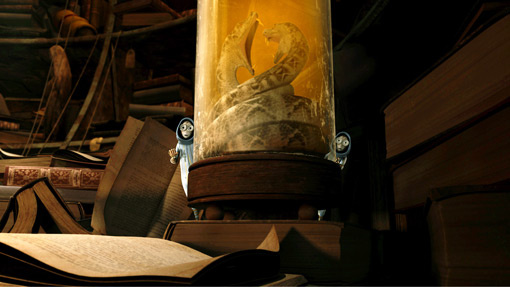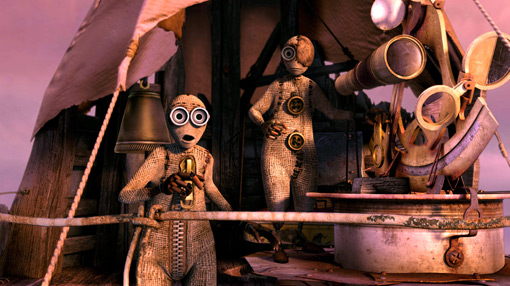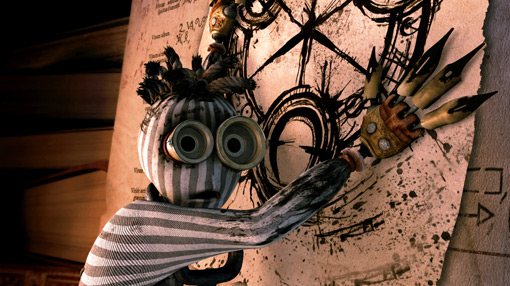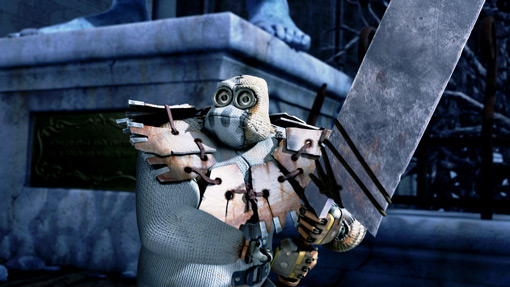A Great Idea, But a Tough Road to the Big Screen

Image: Director Shane Acker, right, reviews a scene with David Baas, department head, animation, at Starz Animation in Toronto, Canada
As Acker plunged back into the storyboarding process, Burton brought in screenwriter Pamela Pettler, who had written Corpse Bride (she also wrote Monster House). “We developed the story and characters in layers,” says Acker. “First, we did an extensive treatment in which I did illustrations to present to the studio and producers. Once that got signed off, we wrote a more robust outline. Pamela has an interesting process in which we wrote all the structural pieces on post-its, so as the story begins to take shape, you can move the plot points and characters points around.”
Creating the feature meant remaking nearly everything from the short. “9 is the same character, but much more refined and detailed,” says Acker. “We felt 9 should be as close as possible to the short, but there was a lot more we could do with expression and emotion. We added more articulation in the mouth, more brow shapes. We started taking liberties with the other characters. We took the character of 5 and split him into 2 and 5 in the movie. The first creature they encounter is definitely a direct descendant of the creature we see in the short. But otherwise, we did do a fair amount of departure from the short.”

A Dark Look
One of the film’s most distinctive aspects is its dark, dramatic look. “In this dead, desolate, ruined world, we tried to create a dark, foreboding palette that represented that,” says Acker. “We didn’t do it to be gloomy, but it makes their journey more arduous and more important. It helped to create empathy for the characters and their struggle. The [mechanical] creatures all have a kind of red tint, and that contrasts with the green of the soul. In the moments of the film that are most intense, you have the contrast between red and green. The rest of it tends to be in earth tones that connect the characters to their environments.”
For the short, continues Acker, he deliberately let things fall into darkness, showing silhouettes and allowing audiences to fill in the world. That also worked for the feature. “We were doing this for a modest budget [$30 million],” he says. “We used this to our advantage.” Another part of the look that continued from the short into the feature was the idea of having moving light sources. “The world is dead, so one way to make it come alive is to have the light source moving,” explains Acker, who says his inspirations for the film included stop-motion filmmakers such as the Brothers Quay and Jan Svankmajer. “So 9’s light staff moves and gives the scene visual interest.”
Acker’s other inspirations for the look included imagery of the aftermath of the two world wars, especially beautiful works of art and architectural achievements, like Gothic cathedrals, that were destroyed. He also did a lot of research into the physicist Robert Oppenheimer. “Although he has a small role in the film, he’s the creator of these creatures and connected to the downfall,” says Acker. “I wanted that character to be core to the human side of the world. He’s a Geppetto figure that haunts this world.”
Although producers Burton and Bekmambetov were busy doing their own projects during 9‘s production, Acker says that they would all get together when he had a newer cut. “They had a critical distance and could see it with fresh eyes, which was great,” says Acker. “Tim was really pushing me to tell as much of the story as possible visually, without relying on dialogue and those were great notes.” The result of that particular note is evident in the film. “We tried to do a lot of invention in terms of finding interesting, clever ways to tell the back story, whether it was newspaper clips, holograms, newsreels, or how the characters communicate by flashing imagery from their eyes. The constant push to explain the movie in a visual sense made us be really creative.”
When it came to finding an animation studio to work with, Acker held an open audition. The competition narrowed down to three studios: Prana in Mumbai; Bardel Entertainment in Vancouver; and Attitude Studios, a French company with an offshoot in Luxembourg. “Attitude felt like the best option for us,” says Acker. “They were able to capture the look and feel and the performance we were looking for.”

A Logjam in Layout
During pre-production, Acker had slowly sent artwork and character packages to Attitude Studios so when he was done with story, they’d all be ready to go with lay-out and animation. “It wasn’t until we were over there that we realized they were building a pipeline as they were going,” he says. He also realized, to his horror, that “layout” meant something different there. “Even though we had the same word for layout, for them, that meant recreating the storyboard exactly,” he says. “They would contort the characters to fit in the space. We had a North American approach – the storyboards are the departure points and layout is where you figure out how to stage and shoot things. So we got really bogged down in layout. They didn’t have a rendering pipeline set up, and it started to become a real logjam.”
The problems compounded. The animators didn’t have the tools to see their shots in context. Continuity went out the window. Acker discovered their pipeline was set up for motion capture, not character animation. “The artists at Attitude were strong but were burdened by the lack of a working pipeline,” he says. “We were slow to discover it wasn’t going to work, and it was killing the artists on both sides.” By now, screenwriter Pettler had also gone on to other projects, leaving Acker to fill in the gaps with writing, something he hadn’t done before.

Rethinking and Regrouping
“I was about to lose my whole creative team and there would be no hope of setting the project up again,” he says. The production had already spent 21 months in Luxembourg, trying to make it work. Then animation producer Jinko Gotoh, who had a hand in Finding Nemo, Space Jam, Dinosaur and others, stepped in. She loved what she saw and got everyone recommitted to making the film.
“Animation is all about creating and exploring a new world,” says Gotoh. “9 does so in a fresh and exciting way. I’ve been looking for stories different from the talking-animal comedies that dominate US animation today.”
“I also saw Shane as representative of a new generation of talent in animation, telling a different kind of visual story,” she continues. “Shane is CGI-savvy and very strong in design. He also understands, from a technical perspective, how to design a CGI film for less money, and yet make it look so rich and full no one would ever question the budget. That’s very difficult to do, especially in CGI.”
That involved moving the animation to another production studio. “David Steinberg, the GM of the Starz Toronto studio, was a colleague of mine at Disney, so I knew I could count on him and others on his team,” say Gotoh. “Having worked in Toronto several years back, I also knew there was a talent base, as well as the necessary Canadian tax credits for our budget. We looked at other studios, but from my experience working as an independent producer, outsourcing CG animation was not going to be easy. Most importantly, you need a facility that understands that we’re making a movie, not just delivering shots. Not many facilities outside of Disney, Pixar, Dreamworks and Blue Sky have had that experience. The others who ventured into feature production all suffered with their first production. 9 had already gone through some hardship and we couldn’t risk any more.”
Acker notes that some of the work was given to Ken Duncan in Pasadena and a chunk of it was initially kept at Attitude. “We wanted everyone to participate and get the film done,” he says. “But a month or so after we restarted, Attitude pulled out entirely, and that extra footage ended up going to Starz.”
Going to Starz Animation proved to be a winning ticket. “They had all the tools we needed,” says Acker. “And they’d tested it because they’d gone through two different productions with it. They spoke our language. They had the North American production model. They had everything we wanted and more.” Furthermore, Starz was in an unexpected down time, so 9 could just slide right into production.

A New Start at Starz
For More Info:
Autodesk Maya
Mental Images mental ray
Eyeon Fusion
Sitex Graphics Air
CineSync
Starz associate producer Graham Moloy said they had the artwork and two sequences from Attitude Studios to use as reference. They had the characters models created at Attitude Studios, but then had to re-rig them all to fit within Starz’ pipeline. “We essentially kept the skeleton that was built and then wiped out everything else and started from scratch,” says Moloy, who says his studio relies on Autodesk Maya with proprietary plug-ins, Mental Images mental ray for rendering, and Eyeon Fusion for compositing.
“At Attitude, they were using Maya but to render they used [Sitex Graphics] Air,” explains Acker. “They had their own set-up tools, so we couldn’t bring the rigs to the Starz pipeline.”
The elaborate and detailed storyboards gave Starz a great jumping off point, says Moloy. “We had the short and we knew ultimately how the characters should move,” he says. The biggest challenge, he says, was that of small characters in a big world. “When you get [down to] eight inches off the ground, you have to put a lot of detail into that surface,” he says. “Once we got into lighting, we had to up-res the ground plate. Otherwise the rubble, even the dirt, wouldn’t hold up. We had to go in and add texture or it would end up looking more like a painting.”
Another challenge was the dark palette. “Generally, most animated films are a bit brighter with only a few dark scenes,” he says. “You have to be careful when you get into blacks that they don’t get too muddy. Our in-house cinematographer/art director Kevin Adams and VFX supervisor Jeff Bell took on those challenges.” The large number of set pieces also added complexity. “A lot had to be built for this show,” says Moloy.
The final challenge was time: Starz had 14 months to do a full-length feature. At its peak, 128 Starz artists worked on the film. For the last few months of production, Acker was in San Francisco (sound was done at Skywalker) and Starz stayed in touch with him by using CineSync, a remote review-and-approval tool based on QuickTime media. “Shane could draw over our frames and step through the shots,” says Moloy. “This tool was key for us, enabling us to do a portion of the show remotely.”
Despite the challenges and time pressures, the mood was upbeat at Starz. “One thing that kept us going was that we knew we had a unique film on our hands and we were lucky enough to be part of it,” says Moloy. “Everyone got behind Shane’s vision.”
Acker’s experience as a first-time feature filmmaker ended up being as daunting an adventure as his own characters endured. At the end, he not only endured but also prevailed. The buzz at Comi-Con 2009 was good and critics have lauded the film’s visual achievements. “It was a tough road,” he says. “It was intense, political and everything else. The studio really supported us. In the end, it’s all good.”
Sections: Creativity Technology
Topics: Feature Project/Case study
Did you enjoy this article? Sign up to receive the StudioDaily Fix eletter containing the latest stories, including news, videos, interviews, reviews and more.